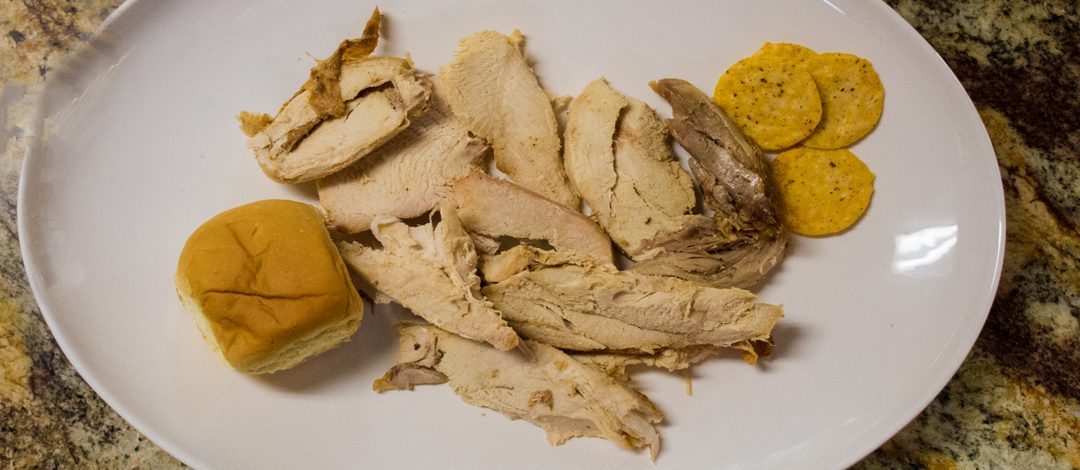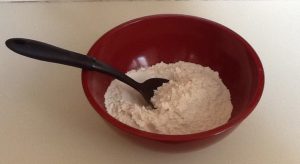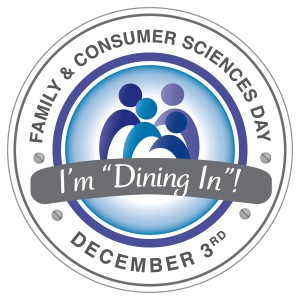
by Ginny Hinton | Nov 30, 2019

Safe and delicious holiday leftovers
Photo Source: UF/IFAS
For some of us, the best part of holiday eating is snacking on the leftovers. There’s just nothing better for a post-holiday lunch than a turkey sandwich with some cranberry dressing. With a little care and attention to detail, holiday foods can be safe and delicious for several days after the big event.
So, what do we all need to know about holiday food safety? Take a look below for some quick and easy tips.
Reheating foods in the oven: Set your oven temperature no lower than 325˚F and reheat to 165˚F for turkey or chicken. Reheat ham to 145˚F. You will need a meat thermometer to check the temperature. If you don’t already have one, they’re easy to find and fairly inexpensive. To keep your meat moist, add a little broth or water and cover it with foil or an oven-proof lid.
Reheating foods in the microwave: To keep your turkey or chicken moist, sprinkle a little broth or water and cover it. You won’t need a lot of extra moisture for microwave cooking. If your microwave doesn’t have a revolving tray, be sure to rotate the meat for even heating. Let it stand for a minute or two after heating, as it will continue to cook for a bit. Just like with oven reheating, use a meat thermometer and heat poultry to 165˚F, ham to 145˚F.
Storing your turkey: It may be a painful thought, but if any turkey, stuffing, or gravy gets left out at room temperature for more than two hours, it needs to be thrown away. It’s better to waste food than to risk getting sick, especially over the holidays! Divide leftovers into small portions so they will quickly and evenly cool. Store in the refrigerator or freeze in appropriate containers.
Important Tips: Use refrigerated turkey, stuffing and gravy within four days. If you freeze your leftovers, use them within six months for best taste and quality. Not sure how long something’s been in the refrigerator or freezer? The old maxim still holds true: When in doubt, throw it out.
Best wishes to you for a safe and happy holiday season!

by Stephanie Herzog | Nov 27, 2019
The holidays are upon us! The holidays are a beloved time of year for many, but they are also a source of stress. Stress is defined by an individual’s values, beliefs, and perceptions, so it may look different to everyone. Whether you’re preparing for parties or family to come visit, dreading interacting with a certain family member, planning your holiday budget, or struggling with remembering a lost loved one, stress affects many people this time of year. Here are three tips for managing your stress this season.

Loving and caring relationships go a long way to relieve stress. (Photo Source: UF/IFAS)
1. Be Meta
Metacognition is thinking about your own thought processes. If you feel your stress winding up, stop and analyze your thought processes and the environment around you.
Ask yourself a question such as:
“Why I am feeling this way?” or “Why did I have this connecting thought and/or emotional reaction because of this specific event?”
Consciously recognize your signs of stress and do something about it:
“I’m feeling stressed because my muscles are tight and I’m irritable, so what is a healthy coping mechanism I like to use, and when can I take a break to go cope?”
Being more aware of your thoughts, feelings, and environment helps keep you in tune with managing your stress in a healthier way.
2. Take A Moment
Remember that to successfully help others, you first need to take care of yourself. The holidays make that even easier to forget, it seems. Too much psychological stress can lead to physical illness, which takes an even bigger toll on your overall well-being. So take a moment to yourself to refresh or recharge, whether it’s five minutes alone meditating or practicing mindfulness/awareness, going for a short walk, or taking an amazing 20-minute power nap. Reach out to friends and family to help you cover your responsibilities (such as caring for children), if needed, while you take a moment. Right now, I’d like you to take a moment and make a list of 3-5 simple things you can do to help yourself de-stress as the holidays approach, so you are armed with coping power when the stress arrives.
3. Don’t Deny
Denial is a poor stress management too; it’s a defense mechanism, not a healthy coping skill. It can be beneficial in the short-term, depending on the situation, but is largely harmful if used long-term. The refusal to believe there’s a problem only brings more stress. Not only does denial hurt you, but it hurts the people around you as well. Remember to trust those you love if they express concern about you or feel as though you’re denying something that’s negatively affecting you. Try not to defend yourself or attack them. First, take a step back, breathe in, and examine any validity to their claim with a good dose of humility. Chances are, they mean well and want to help, so it’s worth a self-examination. The ultimate goal is for you and your loved ones to be healthy and happy, and coping with stress positively is one great avenue to achieving that goal!
Enjoy yourself this time of year as you serve and spend time with others, but remember also to take care of yourself!
Source:
Boss, P. (2002). Family stress management: A contextual approach (2nd ed.). Thousand Oaks, California: Sage Publications.

by Laurie Osgood | Nov 25, 2019

Photo credit: UF/IFAS NW District
Rice and pasta are a staple of most family meals. But did you know these simple grains can lead to a foodborne illness? Uncooked rice and pasta can contain spores of Bacillus cereus, a bacterium that can cause foodborne illness. These spores can survive even when rice or pasta is cooked. If the rice or pasta is left standing at room temperature, like in a pot on the stove, these spores can grow into bacteria. These bacteria will then multiply and produce toxins (poisons) that can cause foodborne illness. Bacillus cereus, sometimes called B. cereus, can cause nausea, vomiting, and abdominal cramps.
Preventing Contamination by B. Cereus
Because B. cereus endospores are heat resistant, they are likely to survive cooking at temperatures that would destroy other foodborne pathogens. Bacillus cereus spores can grow when exposed to heat or improper handling.
Recommendations for Proper Handling of Rice and Pasta:
- Cook rice and pasta at 135ºF or above and maintain at that temperature outside of the refrigerator.
Serve rice or pasta as soon as it is cooked.
- Cool in the refrigerator at 41ºF or below within 2 hours of cooking.
- Store rice or pasta in the fridge using a shallow container or resealable bags.
- Cooked rice or pasta can be stored in airtight containers in the fridge for 3 – 5 days.
- Do not reheat rice or pasta more than once.
During the holidays, celebrations usually center around family and good food, and, therefore, our refrigerators easily can become full. We tend to leave rice or pasta out on the stove when there isn’t any room in the fridge. This is where the problem occurs. By following proper food handling techniques, you can ensure that everyone enjoys the holidays and the fabulous foods that are part of the festivities.
To learn more about Bacillus cereus or other foodborne illnesses, contact your UF/IFAS County Extension Office.
Resources:
UF/IFAS Electronic Data Information Source (EDIS), Preventing Foodborne Illness: Bacillus cereus
The Number of Food Poisoning Cases Caused by Bacillus cereus is on the Rise. (2015, April 1). Infection Control Today. Retrieved from https://www.infectioncontroltoday.com/food-safety/number-food-poisoning-cases-caused-bacillus-cereus-rise

by Judy Corbus | Nov 23, 2019

Flour is considered a raw ingredient so bake before eating. Photo credit: Judy Corbus
There is something about cooler weather that brings out the urge to bake and fill my home with delightful aromas befitting the season. Enjoying the fruits of my labor is a tasty experience but here are 8 tips I follow during prep and afterwards to keep my baked goods safe.
- Wash my hands, baking tools, appliances, and work surfaces with soap and hot water before, during, and after food prep – clean as I go!
- Break eggs in a separate bowl before adding to the batter. This keeps shell fragments out of the batter and, if the egg is spoiled, I don’t ruin the whole project.
- Never eat unbaked flour – this includes dough and batter. Flour is considered a raw ingredient, as it is minimally processed before being packaged for use. Wheat stalks in the field come in contact with birds, rodents, and other bacteria sources, which can spread E. Coli. Raw eggs can contain salmonella so bake foods to the proper internal temperature and resist the urge to lick the bowl, spoons, and beaters.
- Use a food thermometer to check internal temperatures – a brown crust does not equal doneness. Insert the probe food thermometer in the product center and wait for the temperature to maintain a level reading. This Baked Goods Internal Temperatures Chart is a handy guide for determining internal doneness. If the outside is browned but it’s not done in the middle, lay foil lightly over the crust to prevent overbrowning and continue baking until the proper internal temperature is reached.
- Always refrigerate perishable ingredients, pies, cheese-filled breads or baked goods with perishable filling ingredients (this includes eggs, custards, cheese, pizza, meats, casseroles, cream pies, puddings, and crème puffs) within 2 hours of use, preparation, or serving at room temperature. Cookie, scone, biscuit, pie, and yeasted dough may be refrigerated or frozen for later use.
- Cool baked products on clean wire cooling racks on a clean counter or table away from where raw batter or dough are prepared. Don’t cool in the baking pans or directly on counter tops.
- Wash my hands before packaging cooled products.
- Store plain yeast breads at room temperature no longer than 1 to 2 days; freeze for longer term storage. Do not refrigerate unless the bread is filled with perishable ingredients.
Enjoy your favorite baked treats safely this holiday season and beyond!
Sources: Home Baking Food Safety 101
HomeBaking.org
What’s Cooking America
North American Millers Association

by Angela Hinkle | Nov 21, 2019
Make the pledge Tuesday, December 3rd to Dine In for better health – physical, social, and cultural.
Why
Most of us eat every day without thinking about it. We need to eat to nourish our body, so it’s just a regular thing we do. But eating also can be an important social and cultural way for families to come together.

FCS Dine In Day
When we eat together as a family, it gives us the opportunity to practice cultural traditions and share food histories. We get the chance to explore new foods and learn new skills – like eating with chopsticks. We may get the chance to learn and practice table manners and learn literary and conversation skills. Paul Fieldhouse of the Vanier Institute of the Family says, “For young children, ‘table talk’ may be the main source of exposure to family conversation and the expression of thoughts, ideas, and emotions.” Eating the family meal also can help us de-stress by setting a reassuring rhythm and structure to our day.
Eating family meals at home has additional benefits. The University of Washington found that families who cook and eat more often at home tend to eat a healthier diet. Their Healthy Eating Index is high – meaning they eat more fruits and vegetables and less calories, sugar, and fat. They eat smaller portions helping to regulate weight. Some research suggests we eat smaller portions at home because we eat more slowly and talk more. This, however, does not equate to a higher cost. Meals cooked at home generally cost less than those eaten out.
How
So, how can your family eat more meals together at home?
- Try making and eating meals at home a priority for your family. Think about how important it is spending time together.
- Keep it simple. Don’t worry about making a big, fancy meal.
- Start with just a few meals a week. Then slowly add more meals together as you find your “family meal groove.”
- Let the whole family help plan meals. Think about foods your family likes and build around those ideas. Try to get all the MyPlate healthy food groups in – whole grains, plenty of fruits and vegetables of all colors, shapes, and textures, lean plant and animal proteins, and low- and no-fat dairy. Make your grocery list together.
- Let everyone be involved in planning, preparing, table setting, and cleaning up afterwards.
- Make it a goal to start this December 3rd to Dine In for better health.
Resources:
(Still) Eating Together: The Culture of the Family Meal. Retrieved November 16, 2019 from https://vanierinstitute.ca/eating-culture-family-meal/
Cooking at Home Tonight? It’s Likely Cheaper and Healthier. Retrieved November 15, 2019 from https://www.sciencedaily.com/releases/2017/03/170314150926.htm

by Kendra Hughson | Nov 21, 2019
Cranberries were likely a part of the Thanksgiving tradition dating all the way back to the very first one. Native Americans ate dried or fresh cranberries and they used cranberries for dye and medicinal purposes. They also used cranberries to make pemmican – a mixture of berries, dried meat, and fat. Pemmican was a common nutritional dish that could be stored for months. Cranberry sauce became commercially available in its familiar canned form in 1941. These jellied cranberries can now be sold year round. Dried, sweetened cranberries, or “craisins” are also available year round and make a great addition to stuffing and salads. Fresh and frozen cranberries can be found in abundance this time of year. The festive red color and nutrients make them a great addition to many dishes. They also make a great garland for indoor or outdoor trees and other greenery.
Today, cranberries are commonly used in a variety of foods and juices. They are high in Vitamin C and a good source of fiber. Cranberries contain phytochemicals and, as part of a healthy diet, may be associated with certain health benefits like reduced risk of chronic disease. Research on the effectiveness of cranberry juice to prevent urinary tract infections is inconsistent and it should be noted that cranberry juice may interact with some medications, so consult a health care professional.
Check out this video to make a simple cranberry sauce to add to your Thanksgiving table this year.
Sources:
Cape Cod Cranberry Growers’ Association: https://www.cranberries.org/history
Bulletin #4308, Vegetables and Fruits for Health: Cranberries: https://extension.umaine.edu/publications/4308e/











